Mechanical-Level Hardware-In-The-Loop and Simulation in Validation Testing of Prototype Tower Crane Drives
Abstract
1. Introduction
- Signal-level HIL (SHIL) simulation: the control algorithm and control systems are verified and all other elements are replicated as computer models,
- Power-level HIL (PHIL) simulation: real control and supply systems (power electronics) are verified, the electrical motor and mechanical loads are simulated in RT.
- Mechanical-level HIL simulation (MHIL)—a complete drive system is under test, the mechanical loads (or sources) are emulated using controlled drive system (Figure 2).
2. Objective and Scope
- Preparation of simulation models of the electric drive system of the tower crane and simulation of various drive cycles:
- Verification of the correct selection of the structure of the power supply system and control of permanent magnet electric motors,
- Selection of controller parameters in the control system,
- Specifying guidelines for the optimal selection of electric motors and parameterization of the power supply system and machine control.
- Performing experimental tests of the propulsion system components to check and verify that the propulsion system meets the technical assumptions in the field of:
- Lifting speeds for a given weight,
- Movement speeds of the tower crane head for a given weight,
- Power consumption and propulsion efficiency,
- Crane rotation speeds under positive and negative wind loads,
- Determining the level of noise emission in all phases of work,
- Determining the impact of drive operation on the quality of electricity,
- Determining the motor heating curve.
- The proposed research methodology incorporates the MHIL approach, the measurement of electrical, mechanical and thermal parameters of the drive system and the emulation of environmental conditions such as the changes in the ambient temperature.
- The measurements of the limits of the drive system in different conditions such as different drive cycles emulating the real performance of crane drives and the changing supply voltage amplitude representing real construction site conditions.
3. Hoist-Drive System—Simulation Model
3.1. Static Simulations
- (a)
- Trapezoidal profile—acceleration, driving at a constant speed and braking time is indicated in the figure,
- (b)
- Triangular profile—acceleration and deceleration time is 1/2 tm,
- (c)
- The profile described by s-curves—acceleration and deceleration time is the same, each of them is divided into three even stages: acceleration (deceleration) increases linearly, acceleration is constant and acceleration decreases linearly.
3.2. Dynamic Simulations
4. Mechanical-Level Hardware-In-The-Loop Testing for Drives
4.1. Hoist (Main) Drive
- A.
- Directly on the main drive motor using a winding temperature sensor—the signal from the temperature sensor was recorded using the converter control software;
- B.
- Indirectly, in the case of the other 2 motors, the winding temperature is based on changes in the winding resistance during the motor warm-up attempt.
- A.
- The operation with maximum weight: torque T = 130 Nm, set speed n = 1500 rpm—20.4 kW active power,
- B.
- The operation without additional weight: torque T = 10 Nm, set speed n = 3780 rpm—active power approximately 4 kW.
4.2. Trolley Travel Drive
- Power consumption and efficiency of the propulsion system,
- Determining the level of noise emissions in all operating phases,
- Determining the impact of drive operation on the quality of electricity.
- A.
- The maximum speed of 60 m/min, driving for 1 min 30 s break, motor speed 3070 rpm, resistance torque 3.5 Nm;
- B.
- The maximum speed of 45 m/min, driving 1 min 20 s, 30 s break, motor speed 2300 rpm, resistance torque 4.3 Nm;
- C.
- The maximum speed of 30 m/min, driving 2 min, 30 s break, motor speed 1540 rpm, resistance torque 9.2 Nm.
4.3. Jib Rotation Drive
- Power consumption and efficiency of the propulsion system,
- Determining the level of noise emissions in all operating phases,
- Determining the impact of drive operation on the quality of electricity.
5. Preliminary Conclusions Regarding the Efficiency of the Tested Drives
6. Conclusions
Author Contributions
Funding
Conflicts of Interest
References
- Butler, M.; Petre, L.; Sere, K. (Eds.) Model Driven Engineering, volume 2335/2002 of Lecture Notes in Computer Science; Springer: Berlin/Heidelberg, Germany, 2002; Volume 2335. [Google Scholar]
- Skjetne, R.; Egeland, O. Hardware-in-the-loop testing of marine control system. Model. Identif. Control. 2006, 27, 239–258. [Google Scholar] [CrossRef]
- Contreras-Moreno, G.; Toledo, G. (Preliminary Concept) Design of a Mechatronic System to Relief Search and Rescue of Victims after an Earthquake Disaster. Ph.D. Thesis, Fachhochschule Aachen, Aachen, Germany, 2018. [Google Scholar]
- ISO. 9001 Design Verification and Validation—EBS Quality, EBS Quality Solutions, 18 June 2018. Available online: https://www.ebsindy.com/iso-9001-design-verification-and-validation/ (accessed on 10 April 2019).
- NASA. Systems Engineering Handbook; NASA: Washington, DC, USA, 2019.
- Faruque, M.D.O.; Strasser, T.; Lauss, G.; Jalili-Marandi, V.; Forsyth, P.; Dufour, C.; Dinavahi, V.; Monti, A.; Kotsampopoulos, P.; Martinez, J.A.; et al. Real-Time Simulation Technologies for Power Systems Design, Testing, and Analysis. IEEE Power Energy Technol. Syst. J. 2015, 2, 63–73. [Google Scholar] [CrossRef]
- Morawiec, M.; Blecharz, K.; Lewicki, A. Sensorless Rotor Position Estimation of Doubly Fed Induction Generator Based on Backstepping Technique. IEEE Trans. Ind. Electron. 2020, 67, 5889–5899. [Google Scholar] [CrossRef]
- Ogan, R.T. Hardware-In-The-Loop Simulation; Springer: London, UK, 2015. [Google Scholar]
- Lauss, G.F.; Faruque, M.O.; Schoder, K.; Dufour, C.; Viehweider, A.; Langston, J. Characteristics and Design of Power Hardware-in-the-Loop Simulations for Electrical Power Systems. IEEE Trans. Ind. Electron. 2016, 63, 406–417. [Google Scholar] [CrossRef]
- Carmeli, M.S.; Castelli-Dezza, F.; Mauri, M.; Marchegiani, G. A Novel Mechanical Hardware in the Loop Platform for Distributed Generation Systems. Distrib. Gener. Altern. Energy J. 2013, 28, 7–27. [Google Scholar] [CrossRef]
- Leisten, C.; Jassmann, U.; Balshüsemann, J.; Hakenberg, M.; Abel, D. Design and Analysis of a MPC-based Mechanical Hardware-in-the-Loop System for Full-Scale Wind Turbine System Test Benches. IFAC-Pap. 2017, 50, 10985–10991. [Google Scholar] [CrossRef]
- Facchinetti, A.; Mauri, M. Hardware-in-the-Loop Overhead Line Emulator for Active Pantograph Testing. IEEE Trans. Ind. Electron. 2009, 56, 4071–4078. [Google Scholar] [CrossRef]
- Bouscayrol, A. Different Types of Hardware-In-the-Loop Simulation for Electric Drives. In IEEE International Symposium on Industrial Electronics; IEEE: New York, NY, USA, 2008; pp. 2146–2151. [Google Scholar]
- Amitkumar, K.S.; Pillay, P.; Belanger, J. Hardware-in-the-loop Simulations of Inverter Faults in an Electric Drive System. In Proceedings of the 2019 IEEE Energy Conversion Congress and Exposition (ECCE), Baltimore, MD, USA, 29 September–3 October 2019. [Google Scholar]
- Pellegrino, L.; Sandroni, C.; Bionda, E.; Pala, D.; Lagos, D.T.; Hatziargyriou, N.; Akroud, N. Remote Laboratory Testing Demonstration. Energies 2020, 13, 2283. [Google Scholar] [CrossRef]
- Ebe, F.; Idlbi, B.; Stakic, D.E.; Chen, S.; Kondzialka, C.; Casel, M.; Heilscher, G.; Seitl, C.; Bründlinger, R.; Strasser, T.I. Comparison of Power Hardware-in-the-Loop Approaches for the Testing of Smart Grid Controls. Energies 2018, 11, 3381. [Google Scholar] [CrossRef]
- Amitkumar, K.S.; Kaarthik, R.S.; Pillay, P. A versatile power-hardware-in-the-loop-based emulator for rapid testing of transportation electric drives. IEEE Trans. Transp. Electrif. 2018, 4, 901–911. [Google Scholar] [CrossRef]
- Kennel, R.M.; Boller, T.; Holtz, J. Replacement of Electrical (Load) Drives by a Hardware-in-the-Loop System. In Proceedings of the International Aegean Conference on Electrical Machines and Power Electronics and Electro-Motion Joint Conference, Istanbul, Turkey, 8–10 September 2011; pp. 17–25. [Google Scholar]
- Vodyakho, O.; Steurer, M.; Edrington, C.S.; Fleming, F. An induction machine emulator for high-power applications utilizing advanced simulation tools with graphical user interfaces. IEEE Trans. Energy Convers. 2012, 27, 160–172. [Google Scholar] [CrossRef]
- Masadeh, M.A.; Amitkumar, K.S.; Pillay, P. Power electronic converter-based induction motor emulator including main and leakage flux saturation. IEEE Trans. Transp. Electrif. 2018, 4, 483–493. [Google Scholar] [CrossRef]
- Saito, K.; Akagi, H. A power hardware-in-the-loop (P-HIL) test bench using two modular multilevel DSCC converters for a synchronous motor drive. IEEE Trans. Ind. Appl. 2018, 54, 4563–4573. [Google Scholar] [CrossRef]
- Schmitt, A.; Richter, J.; Gommeringer, M.; Wersal, T.; Braun, M. A Novel 100 kW Power Hardware-in-the-Loop Emulation Test Bench for Permanent Magnet Synchronous Machines with Nonlinear Magnetics. In Proceedings of the 8th International Conference on Power Electronics Machines and Drives (PEMD 2016), Glasgow, UK, 19–21 April 2018; pp. 1–6. [Google Scholar]
- Sutő, Z.; Balogh, A.; Kiss, D.; Veréb, S.; Varjasi, I. Power Hil Emulation of AC Machines with Parallel Connected ANPC Bridge Arms. In Proceedings of the IEEE 18th International Power Electronics and Motion Control Conference (PEMC), Budapest, Hungary, 26–30 August 2018; pp. 592–598. [Google Scholar]
- Morawiec, M.; Lewicki, A. Application of Sliding Switching Functions in Backstepping Based Speed Observer of Induction Machine. IEEE Trans. Ind. Electron. 2020, 67, 5843–5853. [Google Scholar] [CrossRef]
- Lee, Y.; Kwon, Y.; Sul, S. DC-link Voltage Design of High-Bandwidth Motor Emulator for Interior Permanent-Magnet Synchronous Motors. In Proceedings of the IEEE Energy Conversion Congress and Exposition (ECCE), Portland, OR, USA, 23–27 September 2018; pp. 4453–4459. [Google Scholar]
- Drobnič, K.; Gašparin, L.; Fišer, R. Fast and Accurate Model of Interior Permanent-Magnet Machine for Dynamic Characterization. Energies 2019, 12, 783. [Google Scholar] [CrossRef]
- Blecharz, K.; Morawiec, M. Nonlinear Control of a Doubly Fed Generator Supplied by a Current Source Inverter. Energies 2019, 12, 2235. [Google Scholar] [CrossRef]
- Zhuang, X.; Hibino, S.; Harakawa, M.; Terabe, R.; Ozaki, T.; Nagano, T. Hardware-In-the-Loop Simulation of a Machine Model with Real-Time Animation. In Proceedings of the 2014 International Power Electronics Conference (IPEC-Hiroshima 2014—ECCE ASIA), Hiroshima, Japan, 18–21 May 2014; pp. 2638–2643. [Google Scholar]
- Jarzebowicz, L. Errors of a Linear Current Approximation in High-Speed PMSM Drives. IEEE Trans. Power Electron. 2017, 32, 8254–8257. [Google Scholar] [CrossRef]
- Wachowiak, D. Genetic Algorithm Approach for Gains Selection of Induction Machine Extended Speed Observer. Energies 2020, 13, 4632. [Google Scholar] [CrossRef]
- Dworakowski, P.; Wilk, A.; Michna, M.; Fouineau, A.; Guillet, M. Lagrangian model of an isolated dc-dc converter with a 3-phase medium frequency transformer accounting magnetic cross saturation. IEEE Trans. Power Deliv. 2020, 35, 10. [Google Scholar] [CrossRef]
- Kutt, F.; Michna, M.; Kostro, G. Multiple Reference Frame Theory in the Synchronous Generator Model Considering Harmonic Distortions Caused by Nonuniform Pole Shoe Saturation. IEEE Trans. Energy Convers. 2020, 35, 166–173. [Google Scholar] [CrossRef]
- Nagano, T.; Harakawa, M.; Ishikawa, J.; Iwase, M.; Koizumi, H. Model Based Development Using Hardware-in-the-Loop Simulation for Drive System in Industrial Machine. Mech. Eng. Robot. Res. 2019, 8, 46–51. [Google Scholar] [CrossRef]
- OJEU. Directive 2006/42/EC of the European Parliament and of the Council of 17 May 2006 on Machinery, and Amending Directive 95/16/EC; OJEU: Aberdeen, UK, 17 May 2006. [Google Scholar]


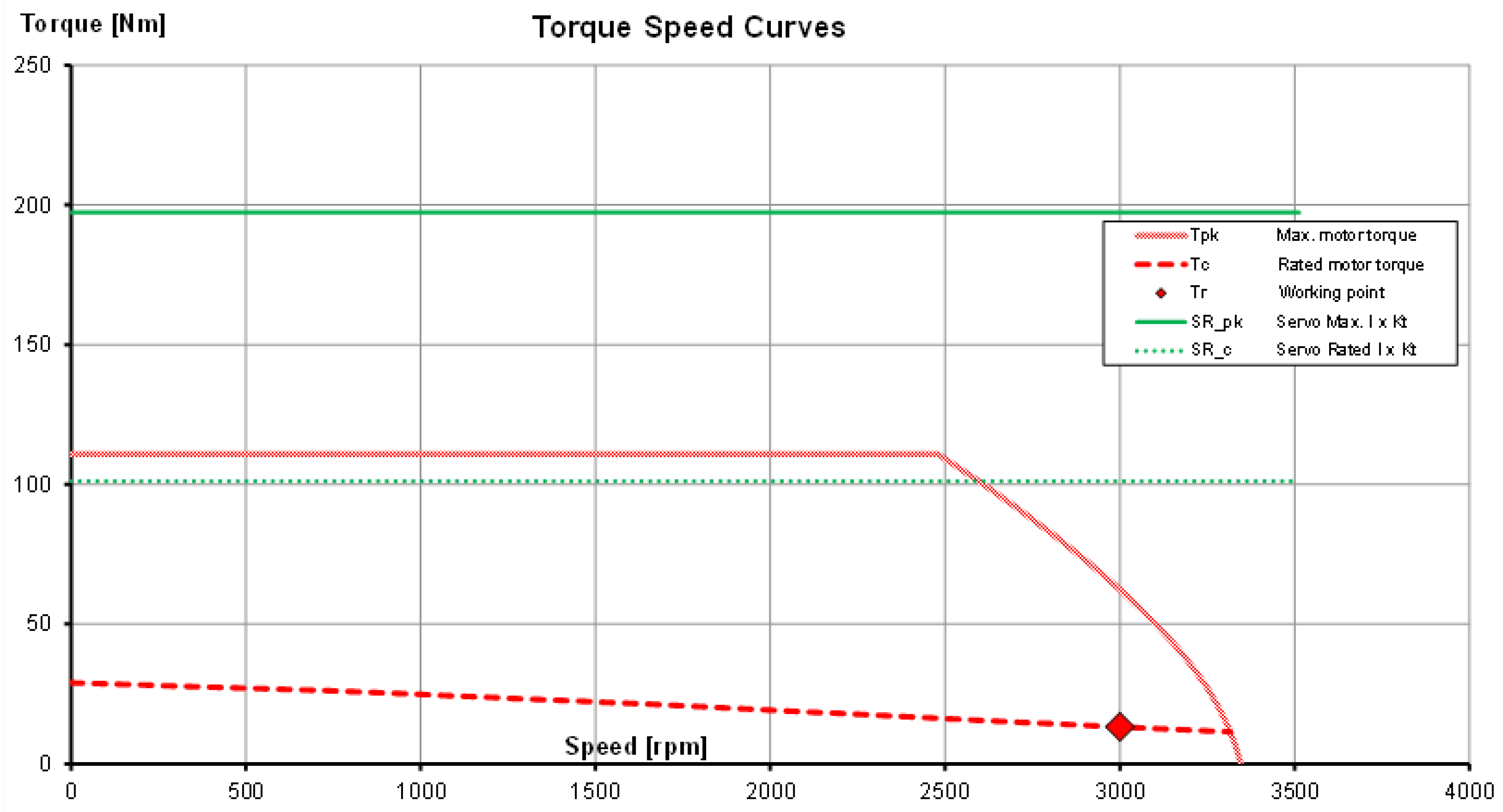
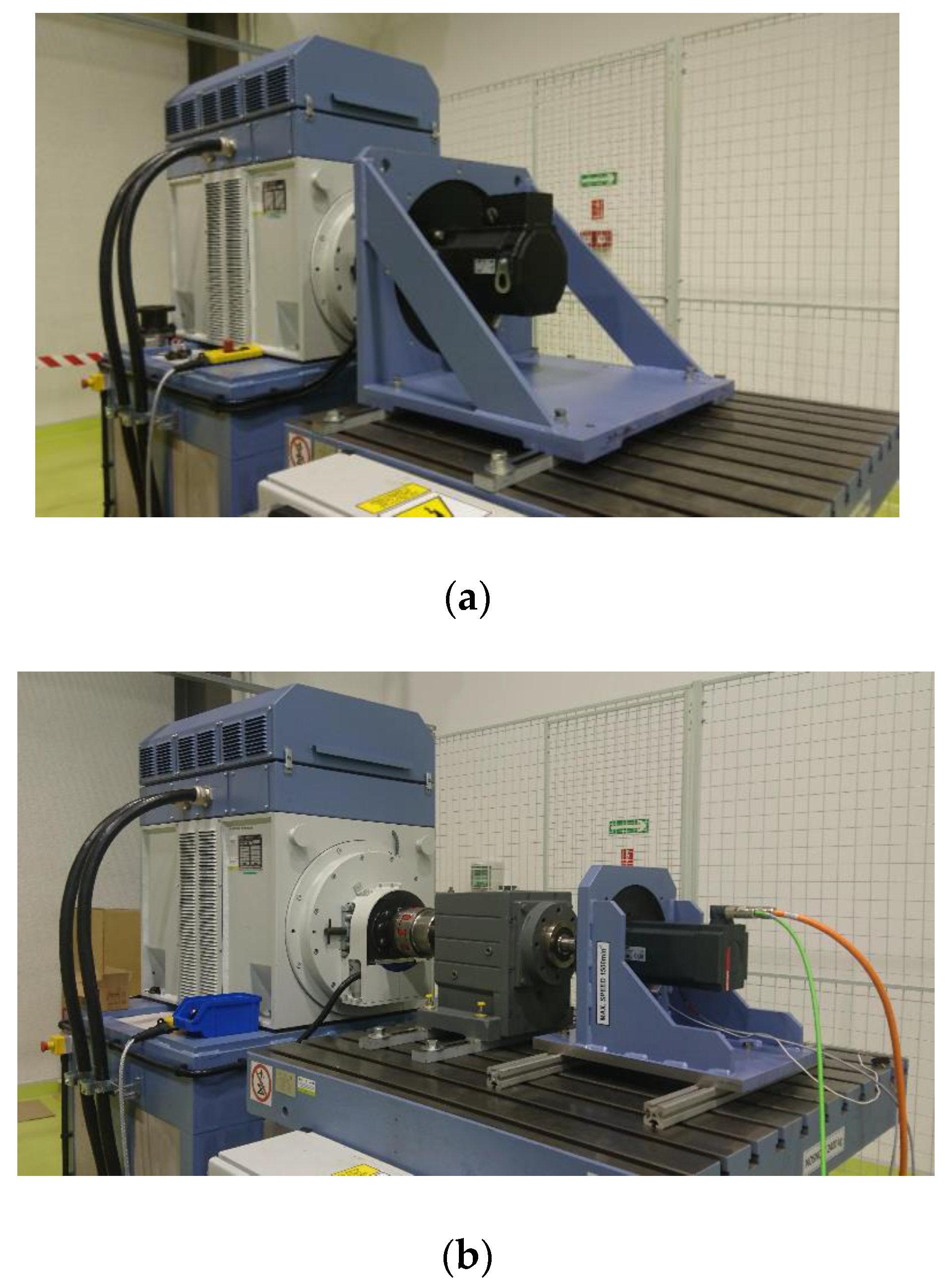
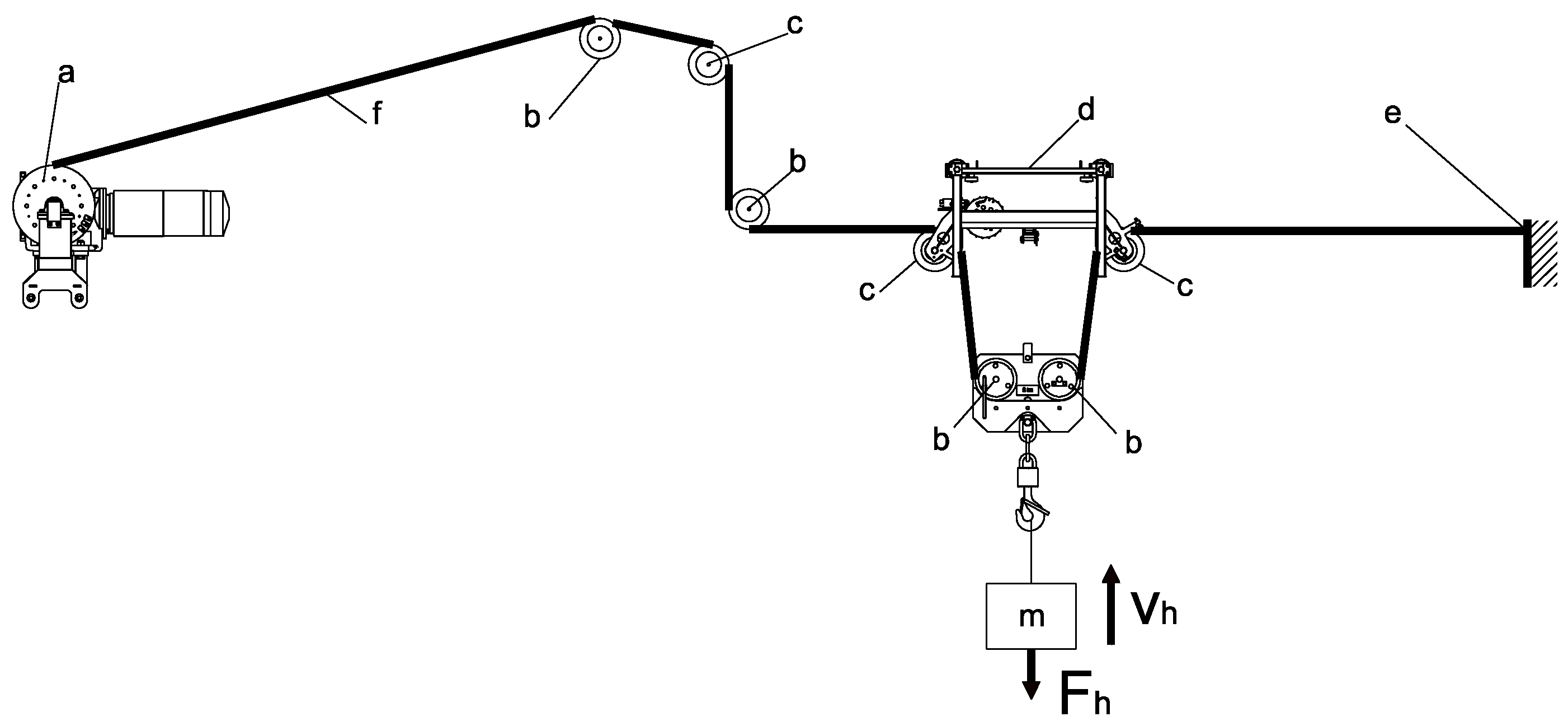
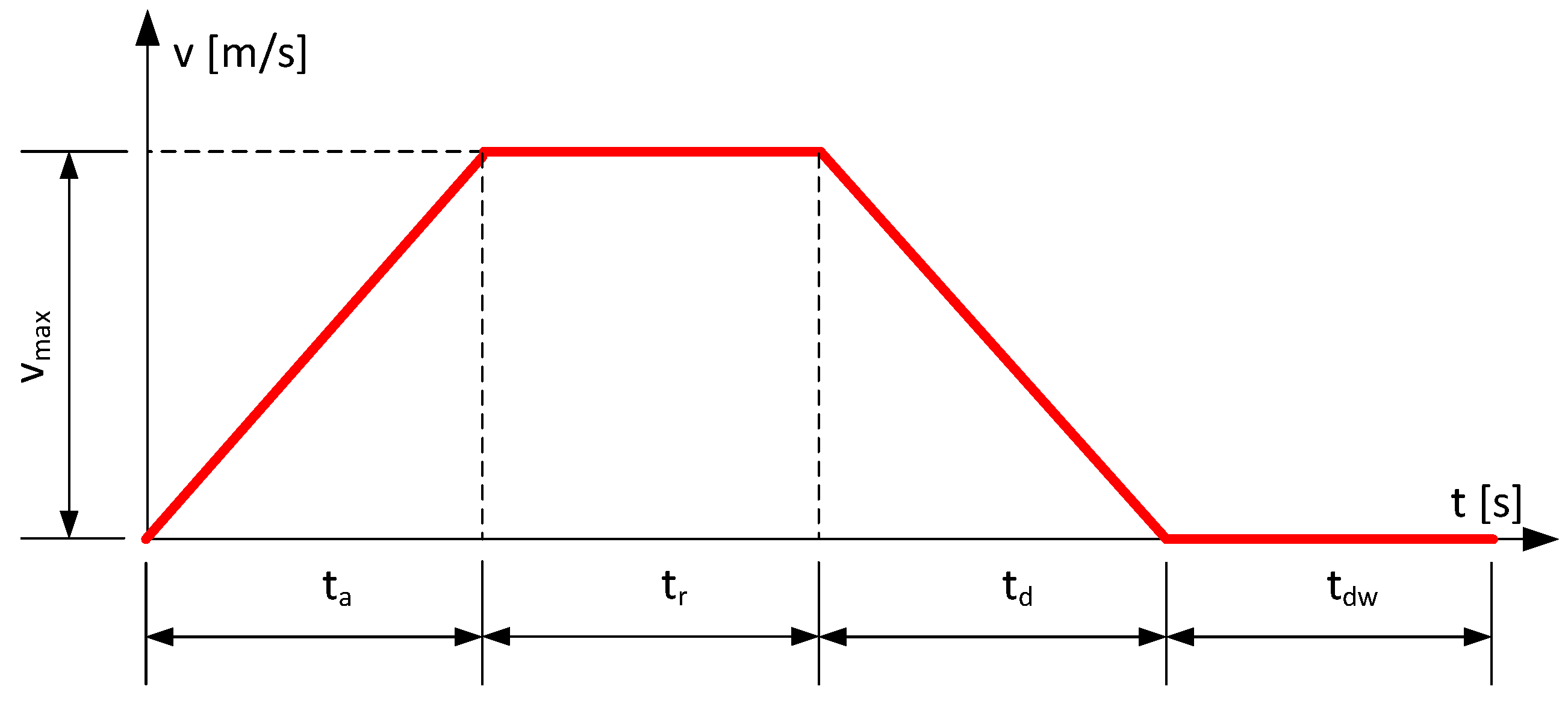
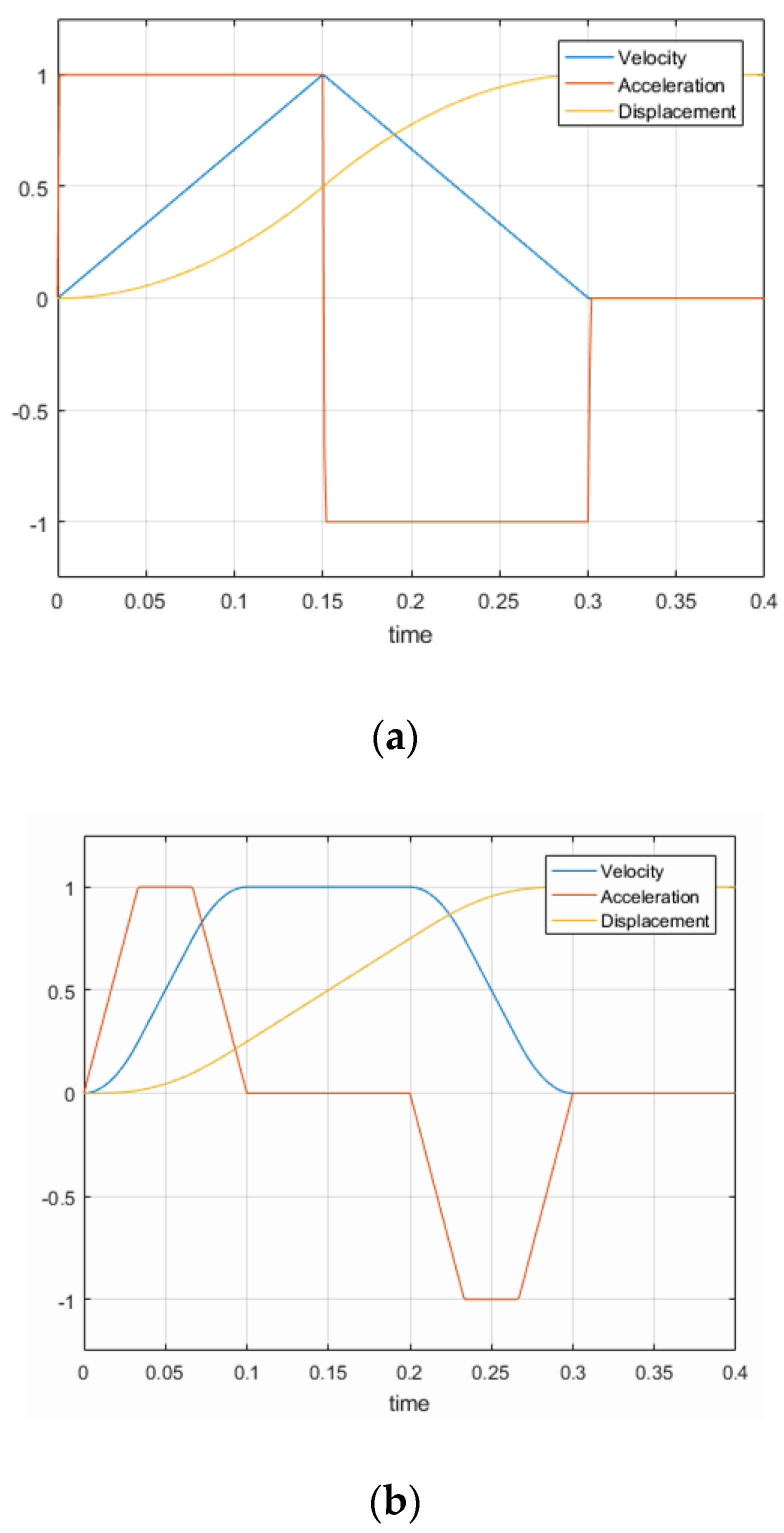
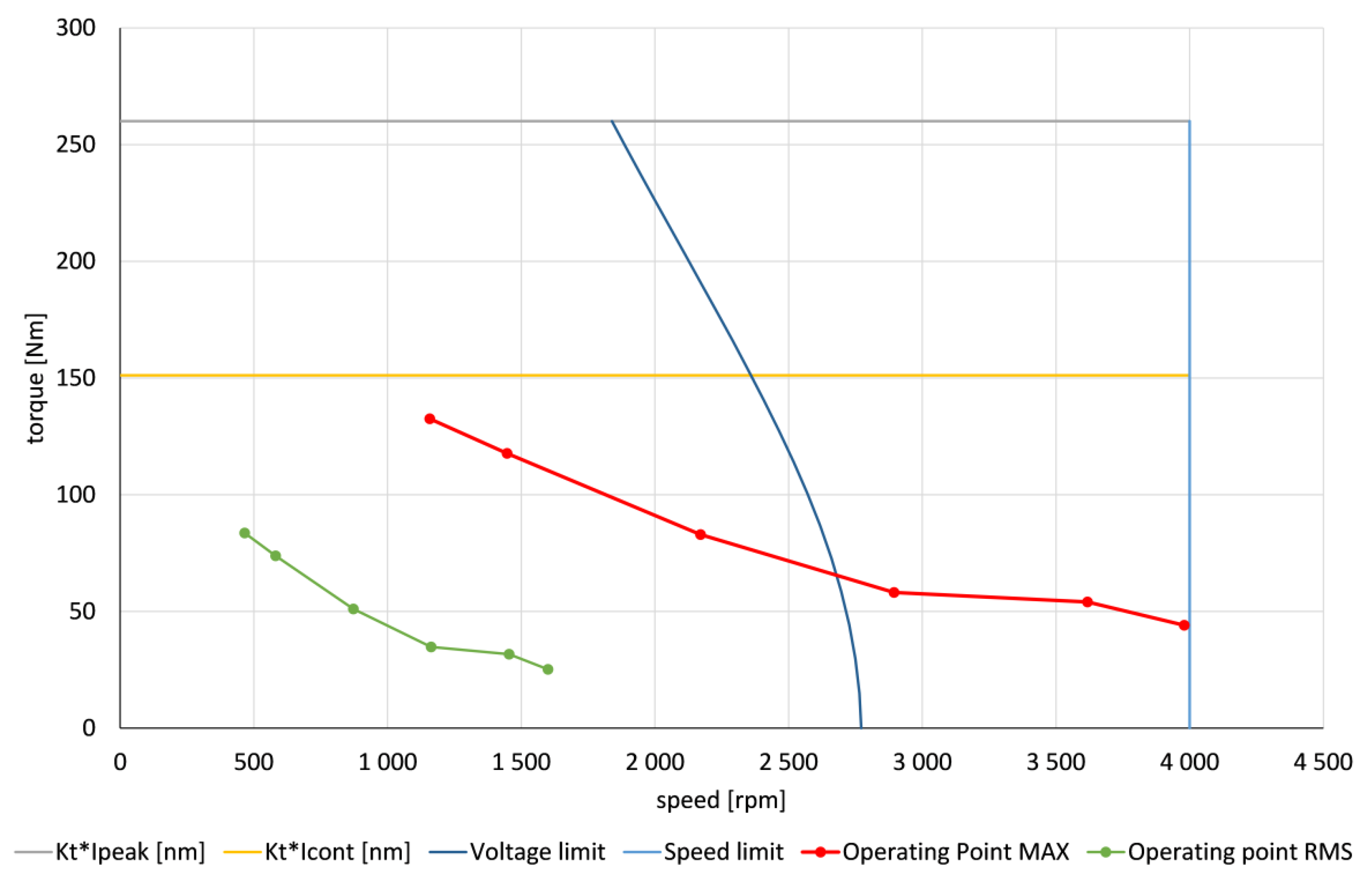
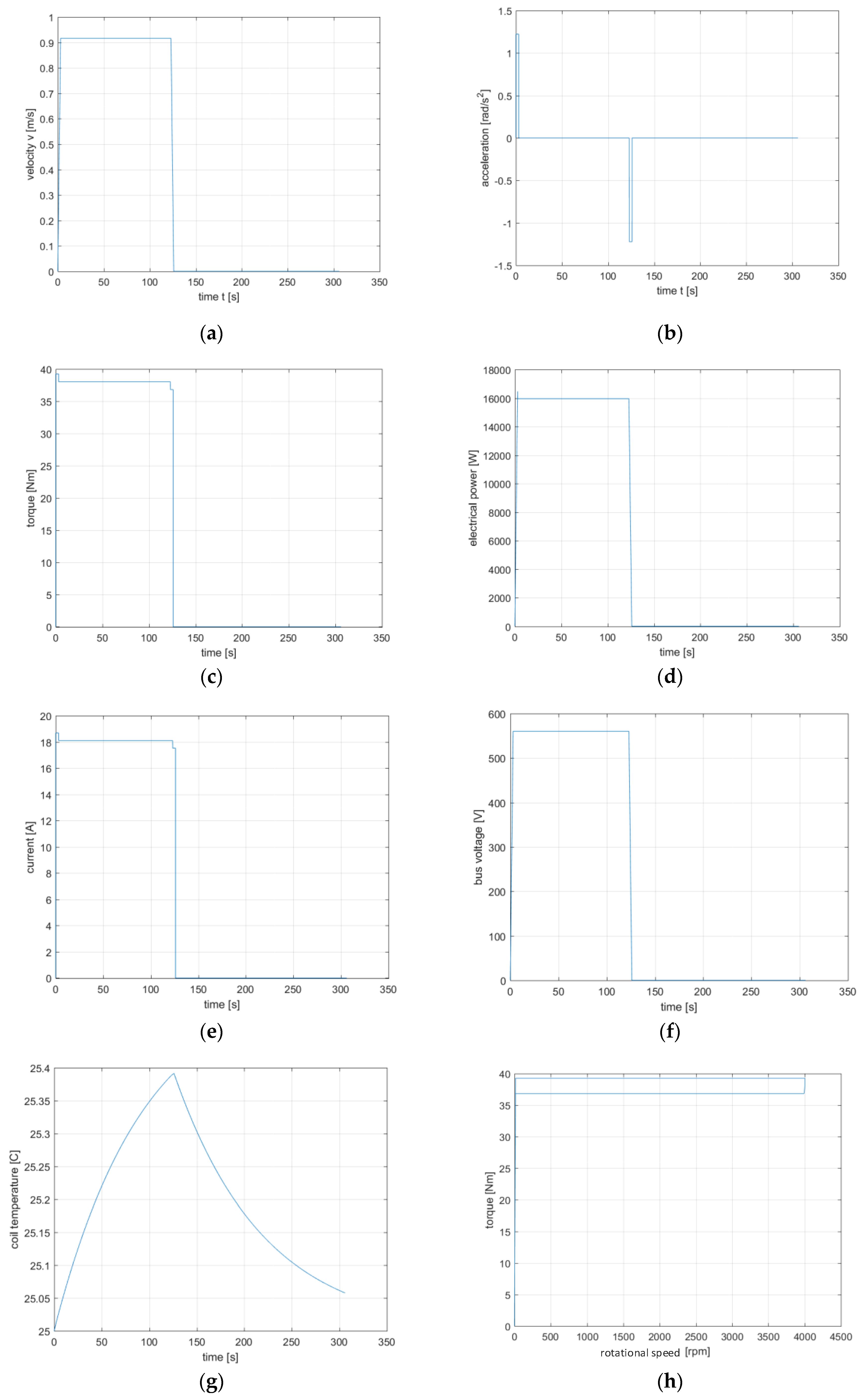
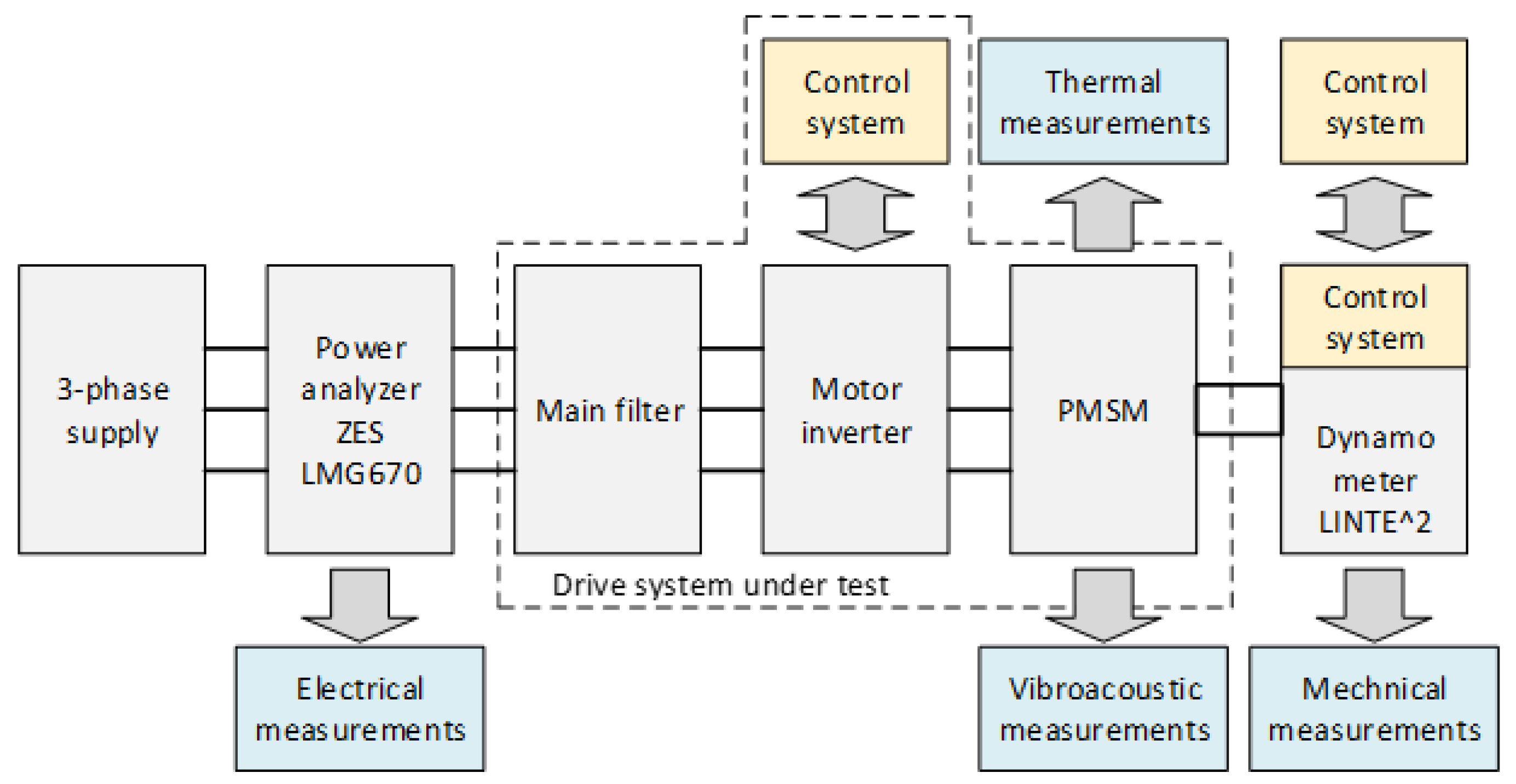

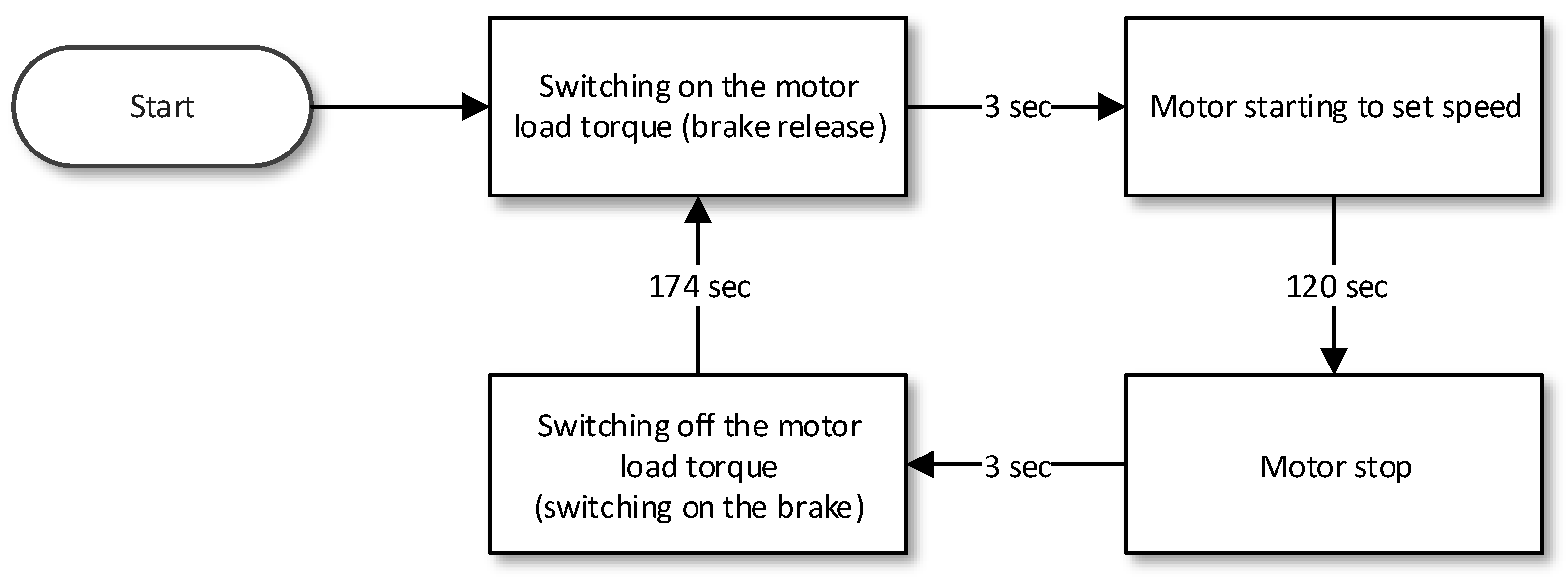

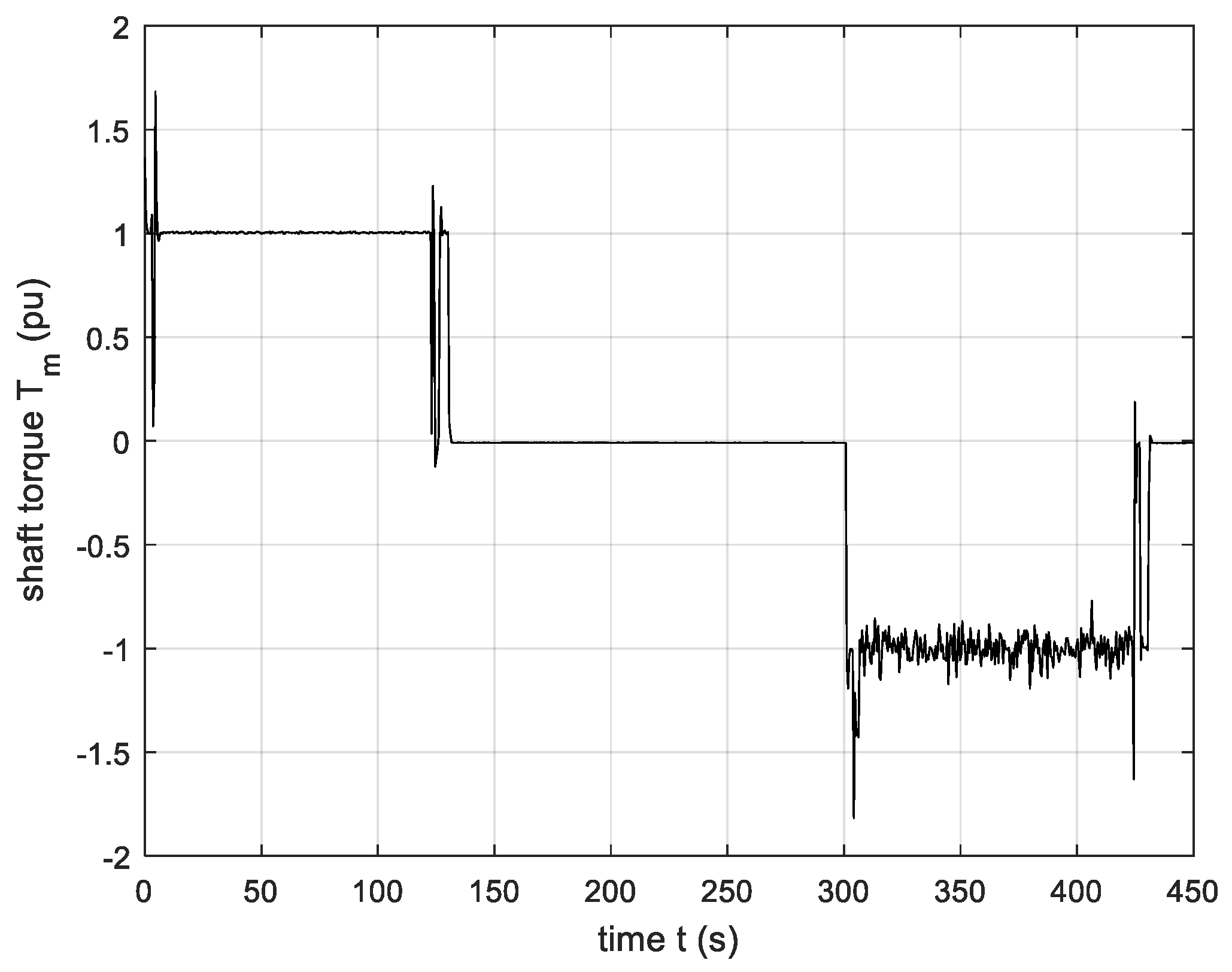
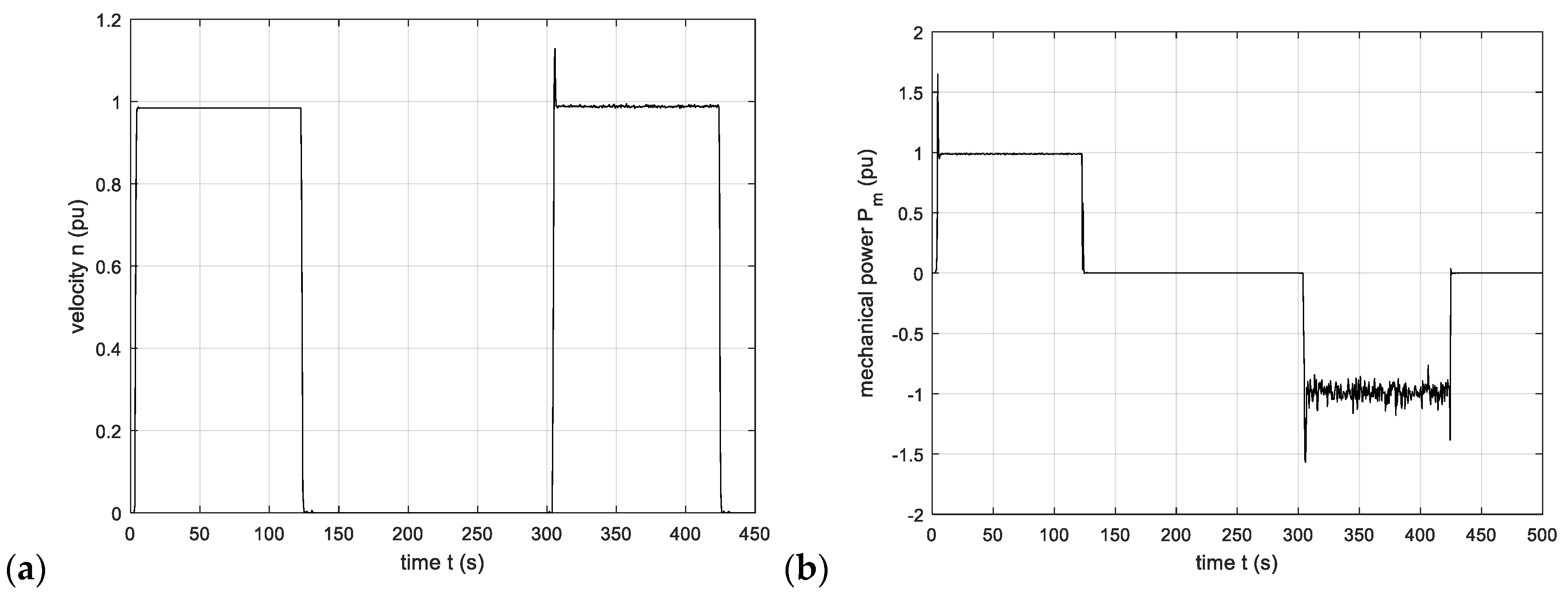
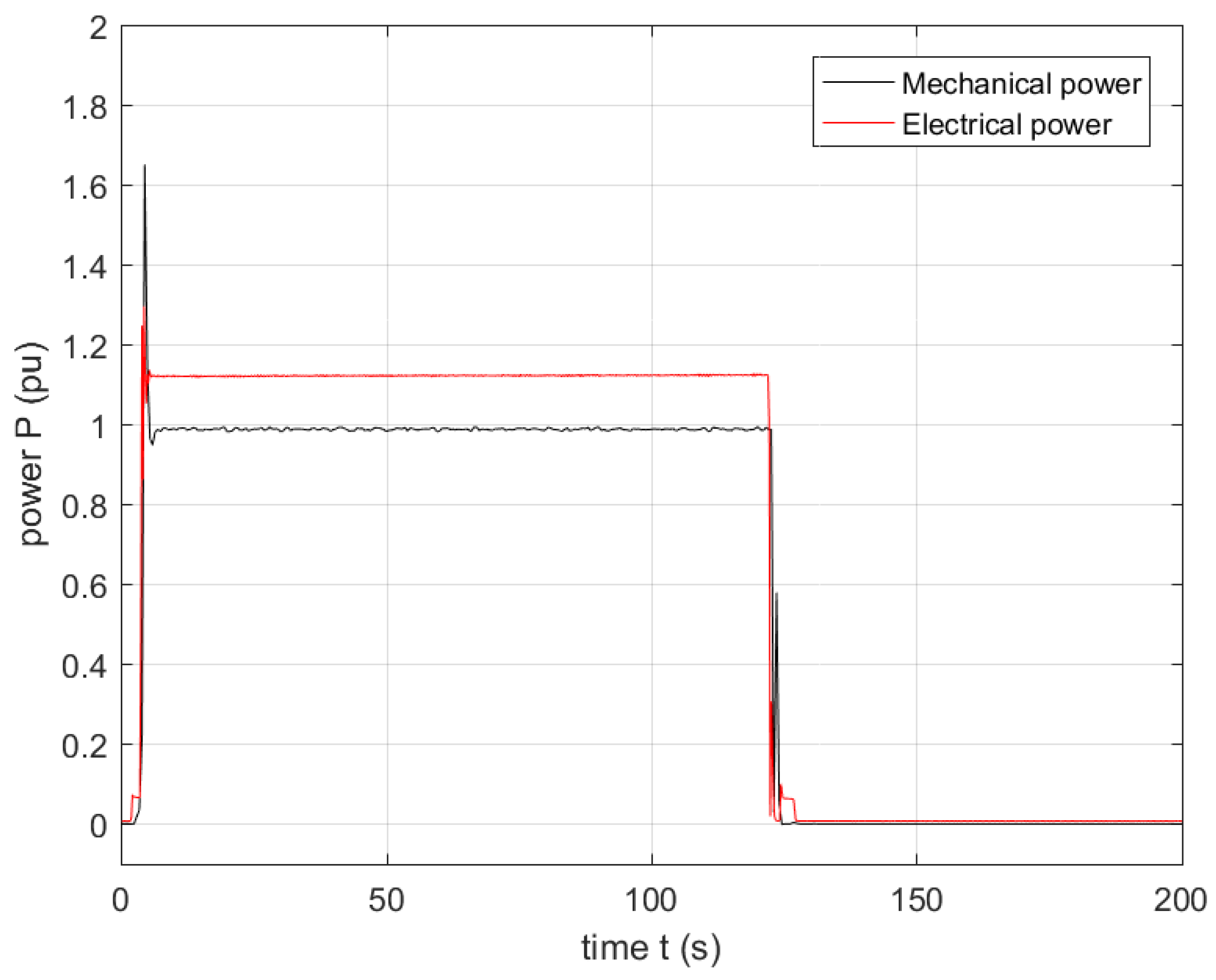

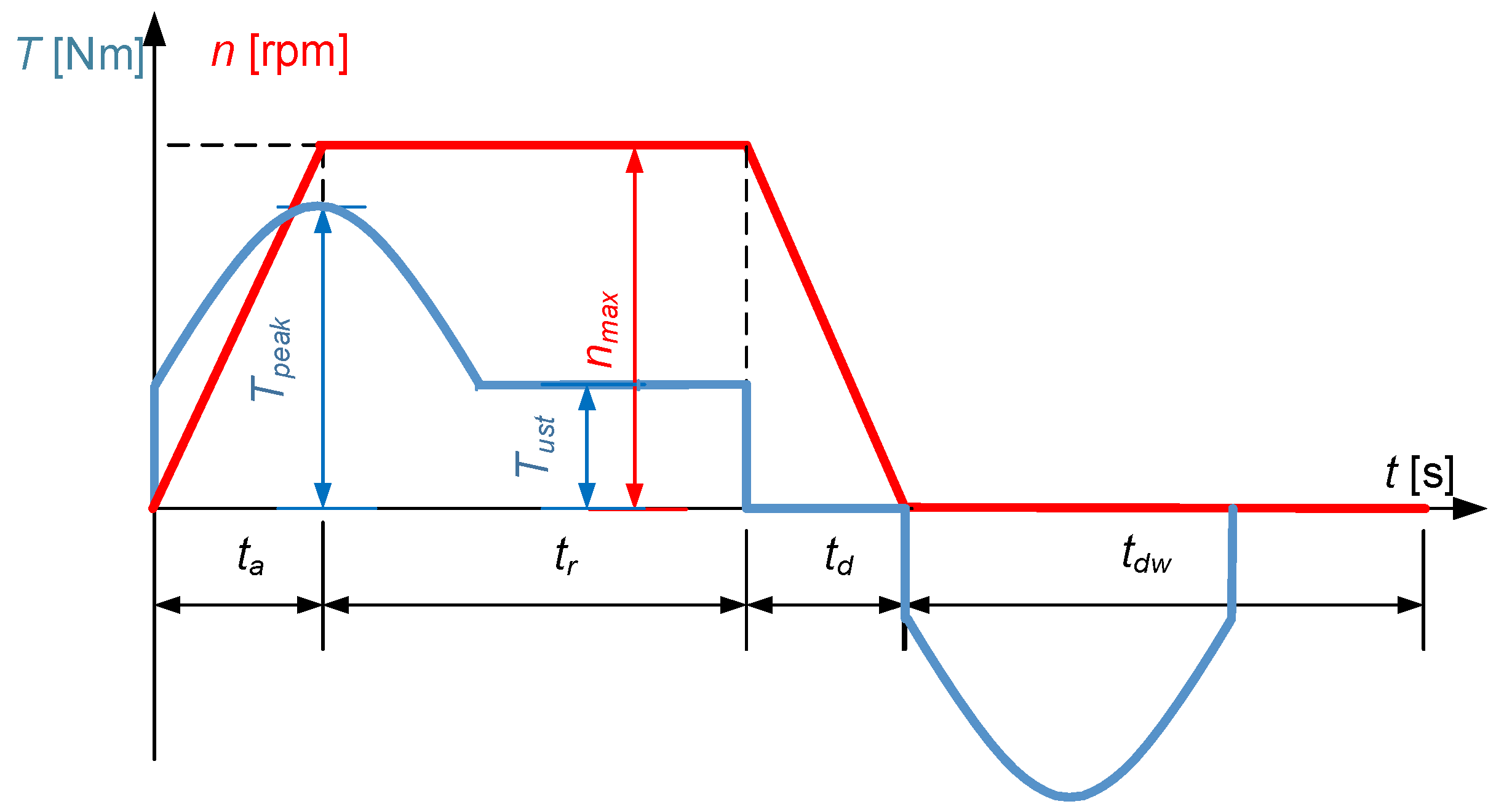
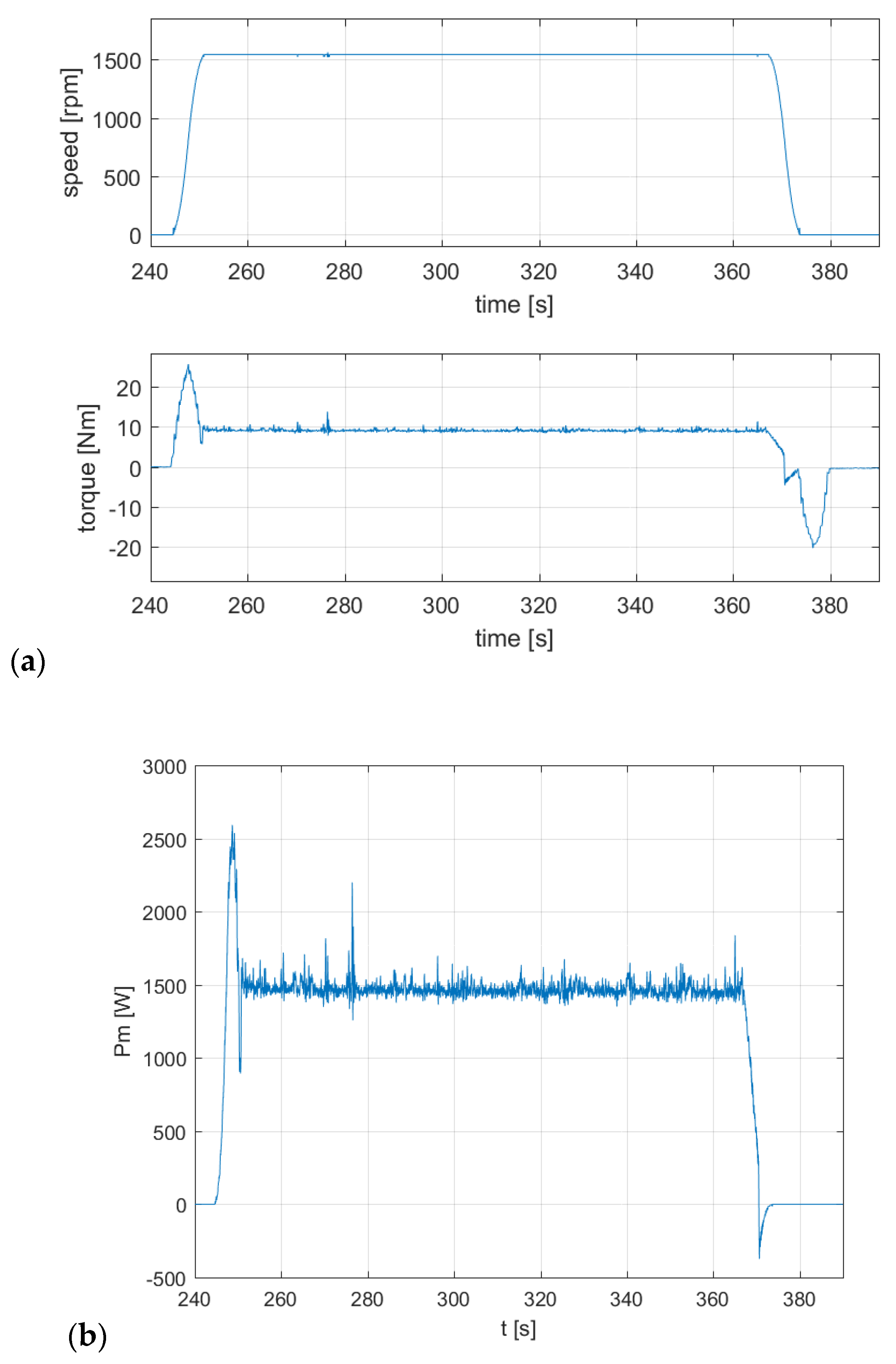
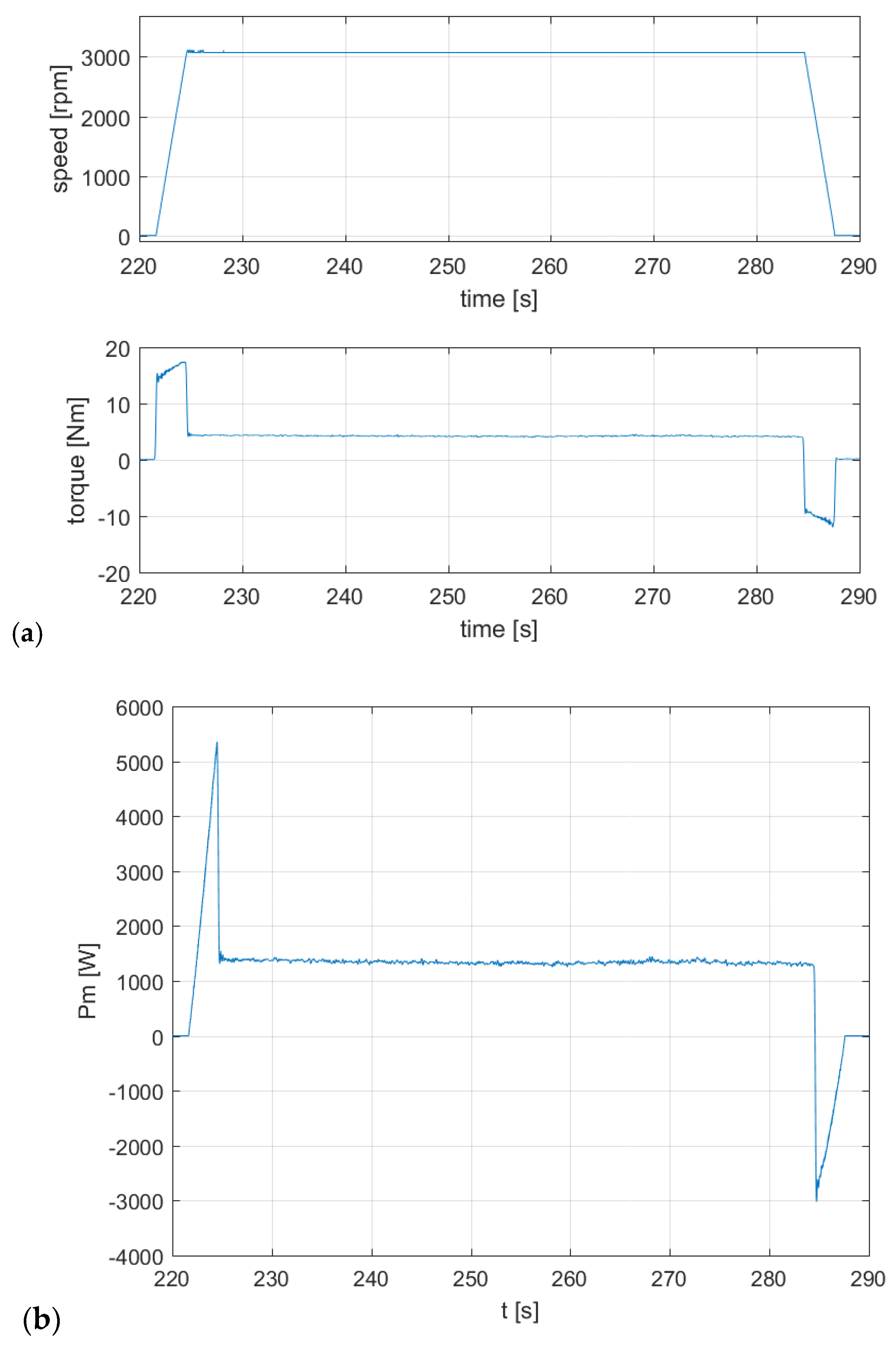
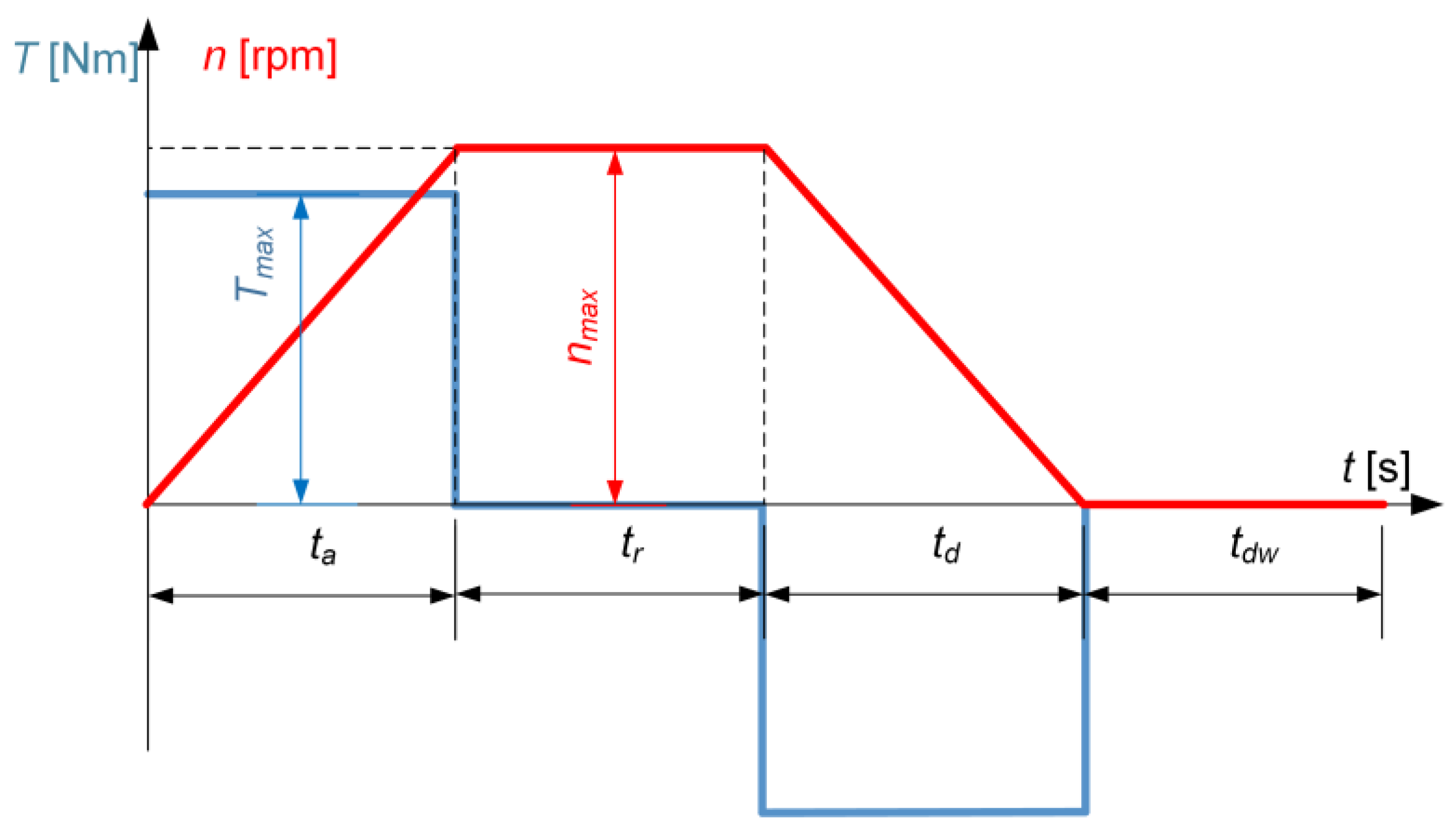
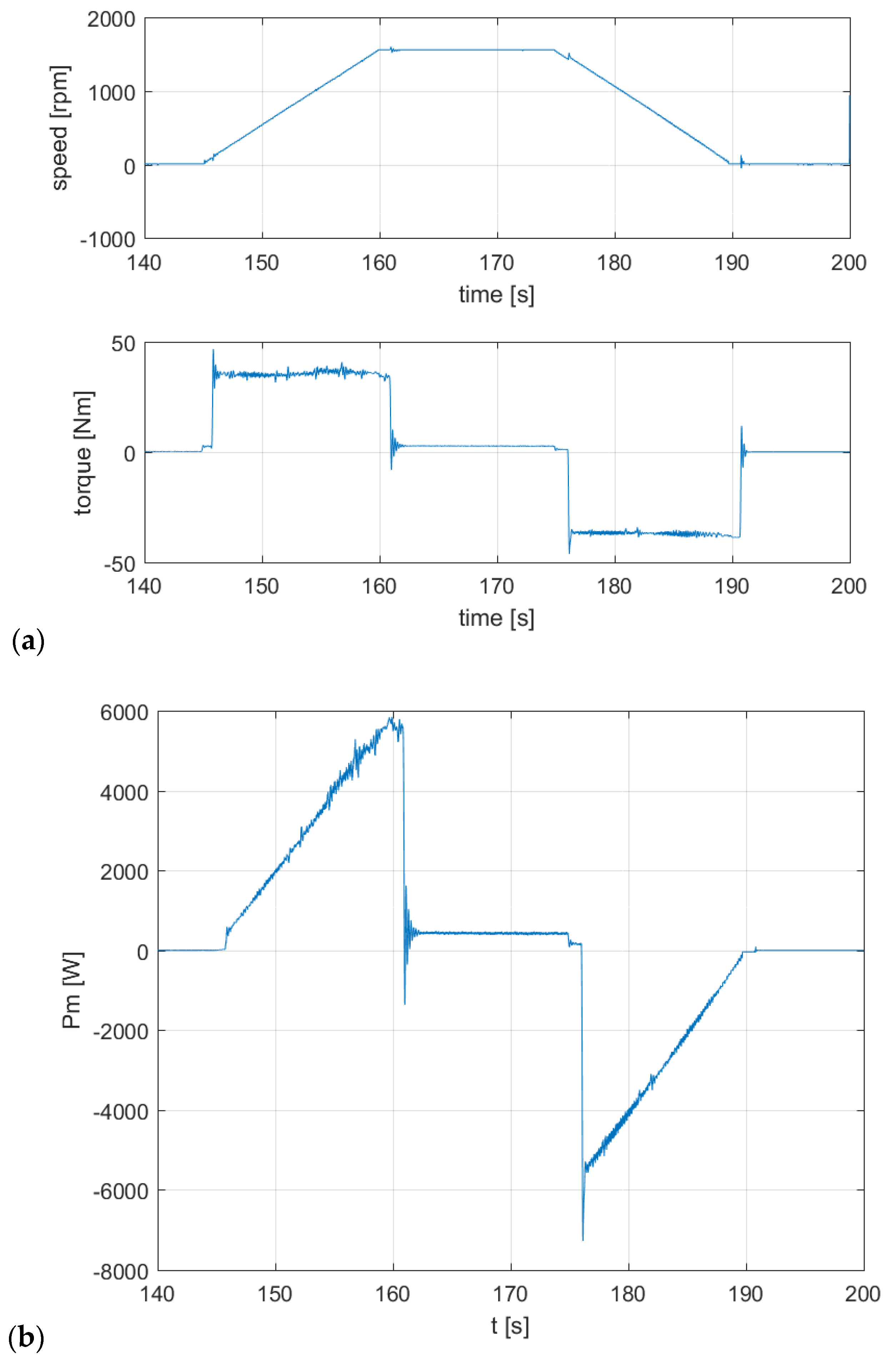
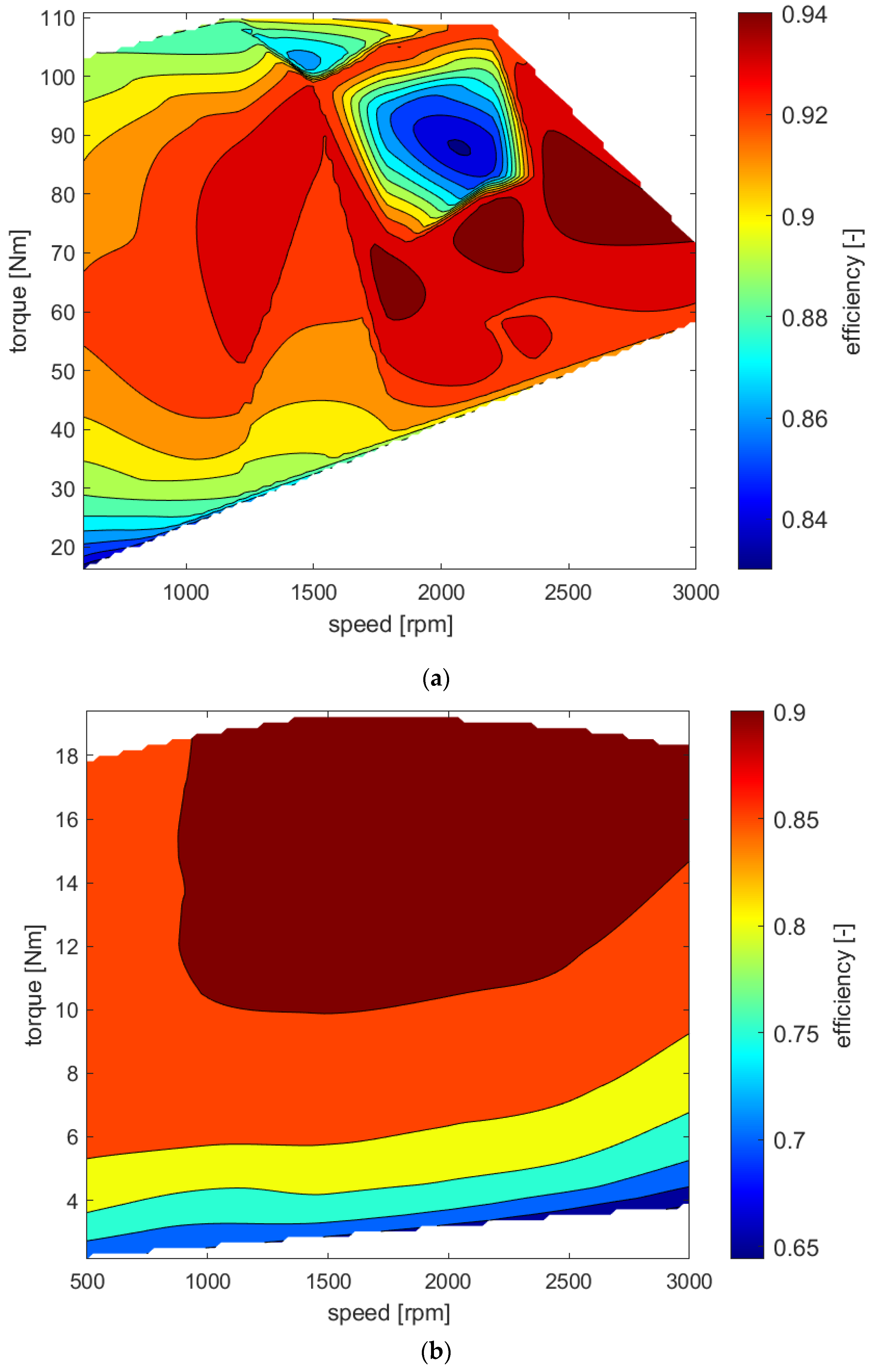
| Drive | Hoist Winch | Jib Rotation and Trolley Travel |
|---|---|---|
| Standstill torque | 130 Nm | 29 Nm |
| Standstill current | 62 A | 17.2 A |
| Max mechanical speed | 4500 rpm | 6000 rpm |
| Max. rated mains voltage | 480 V | 480 V |
| Rated torque (400V) | 70 Nm | 13.2 Nm |
| Rated speed (400V) | 2200 rpm | 3000 rpm |
| Rated power (400V) | 16.1 kW | 4.15 kW |
| Peak torque | 456 Nm | 111 Nm |
| Peak current | 310 A | 80.9 A |
| Torque constant | 2.1 Nm/A | 1.68 Nm/A |
| Voltage constant | 140 mV/rpm | 116 mV/rpm |
| Number of poles | 10 | 10 |
| Static friction torque | 1.83 Nm | 0.15 Nm |
| Thermal time constant | 94 min | 41 min |
| Rotor moment of inertia | 334 kgcm2 | 29 kgcm2 |
| Weight | 85 kg | 17.4 kg |
| Name | Indicator | Value | |
|---|---|---|---|
| 1 | Load weight | 1400.00 kg | |
| 2 | Additional weight | 100.00 kg | |
| 3 | Gear ratio | 57.17- | |
| 4 | Gear efficiency | 0.90 | |
| 5 | Gear moment of inertia | 0.00 kgm2 | |
| 6 | Drum diameter | 0.50 m | |
| 7 | Pulley ratio | 2.00 | |
| 8 | Pulley efficiency | 0.94 | |
| 9 | Pulley moment of inertia | 0.00 kgm2 | |
| 10 | Electric motor efficiency | 0.90 | |
| 11 | Motor moment of inertia | 0.03 kgm2 | |
| Name | Indicator | Value | |
|---|---|---|---|
| 1 | Lifting Speed (Maximum) | 55.00 m/min | |
| 2 | Motion Profile | profile | trapezoidal |
| 3 | Acceleration time | 3.00 s | |
| 4 | Travelling time at a constant speed | 120.00 s | |
| 5 | Braking time | 3.00 s | |
| 6 | Break time/waiting times | 180.00 s | |
| Name | Indicator | Value | |
|---|---|---|---|
| 1 | Total mass | 1500.00 kg | |
| 2 | Height/distance | 112.75 m | |
| 3 | Lifting time | 126.00 s | |
| 4 | Total Cycle Time | 306.00 s | |
| 5 | Work cycle | 41.2% | |
| 6 | The maximum linear speed of weight | 0.92 m/s | |
| 7 | Weight average linear speed | 0.37 m/s | |
| 8 | The maximum angular speed of the pulley | 7.29 rad/s | |
| 9 | The maximum angular speed of the motor | 416.75 rad/s | |
| 10 | Maximum motor angular speed | 3979.63 rpm | |
| 11 | The average angular speed of the motor | 167.5 rad/s | |
| 12 | Linear maximum acceleration (weight) | 0.31 m/s2 | |
| 13 | Maximum angular acceleration (of the motor) | 138.92 rad/s2 | |
| 14 | Linear effective acceleration (weight) | 0.04 m/s2 | |
| 15 | Angular effective acceleration (motor) | 19.45 rad/s2 | |
| 16 | Maximum acceleration force | 458.33 N | |
| 17 | Weigh force | 14,715 N | |
| 18 | Friction force (additional) | 0 N | |
| 19 | Breaking force | 14,715 N | |
| 20 | Maximum resistance force | 15,173.3 N | |
| 21 | Resistance force effective | 9442.45 N | |
| 22 | The moment of inertia of rotating masses converted to the rotor shaft | 0.03 kg m2 | |
| 23 | Maximum dynamic torque | 4.64 Nm | |
| 24 | Effective dynamic torque | 0.65 Nm | |
| 25 | Torque on the motor shaft (maximum) | 45.9 Nm | |
| 26 | Effective torque on the motor shaft | 27.03 Nm | |
| 27 | Maximum mechanical power | 19,137 W | |
| 28 | Effective mechanical power | 4527 W | |
| 29 | Maximum current | 21.87 A | |
| 30 | Effective current | 12.87 A | |
| 31 | Maximum copper losses | 40.33 W | |
| 32 | Effective copper losses | 13.18 W | |
| 33 | Maximum motor power | 19,177 W | |
| 34 | Effective motor power | 4540 W | |
| 35 | Line-to-line voltage | 557 V | |
| 36 | DC bus voltage | 682 V | |
| Cycle | C | A | ||
|---|---|---|---|---|
| Accelerating | Braking | Accelerating | Braking | |
| Average speed | 1540 rpm | 3070 rpm | ||
| Average mechanical torque | 9.13 Nm | 4.17 Nm | ||
| Average mechanical power | 1.472 kW | 1.340 kW | ||
| Maximum mechanical power | 2.592 kW | 0.37 kW | 5.349 kW | 3.014 kW |
| Average active electrical power consumed | 1.192 kW | 1.744 kW | ||
| Maximum active electrical power consumed | 3.144 kW | 9.695 kW | ||
| Drive system efficiency | 90.7% | 75.5% | ||
| Accelerating | Braking | |
|---|---|---|
| Average speed | 1540 rpm | |
| Average mechanical torque | 35.0 Nm | 37.0 Nm |
| Average mechanical power | 3.233 kW | |
| Maximum mechanical power | 5.9 kW | 7.2 kW |
| The effective value of mechanical power | 3.643 kW | |
| Average active electrical power consumed | 4.14 kW | To the resistor |
| Maximum electrical power consumed | 6.732 kW | To the resistor |
| Drive system efficiency | 88% | |
Publisher’s Note: MDPI stays neutral with regard to jurisdictional claims in published maps and institutional affiliations. |
© 2020 by the authors. Licensee MDPI, Basel, Switzerland. This article is an open access article distributed under the terms and conditions of the Creative Commons Attribution (CC BY) license (http://creativecommons.org/licenses/by/4.0/).
Share and Cite
Michna, M.; Kutt, F.; Sienkiewicz, Ł.; Ryndzionek, R.; Kostro, G.; Karkosiński, D.; Grochowski, B. Mechanical-Level Hardware-In-The-Loop and Simulation in Validation Testing of Prototype Tower Crane Drives. Energies 2020, 13, 5727. https://doi.org/10.3390/en13215727
Michna M, Kutt F, Sienkiewicz Ł, Ryndzionek R, Kostro G, Karkosiński D, Grochowski B. Mechanical-Level Hardware-In-The-Loop and Simulation in Validation Testing of Prototype Tower Crane Drives. Energies. 2020; 13(21):5727. https://doi.org/10.3390/en13215727
Chicago/Turabian StyleMichna, Michał, Filip Kutt, Łukasz Sienkiewicz, Roland Ryndzionek, Grzegorz Kostro, Dariusz Karkosiński, and Bartłomiej Grochowski. 2020. "Mechanical-Level Hardware-In-The-Loop and Simulation in Validation Testing of Prototype Tower Crane Drives" Energies 13, no. 21: 5727. https://doi.org/10.3390/en13215727
APA StyleMichna, M., Kutt, F., Sienkiewicz, Ł., Ryndzionek, R., Kostro, G., Karkosiński, D., & Grochowski, B. (2020). Mechanical-Level Hardware-In-The-Loop and Simulation in Validation Testing of Prototype Tower Crane Drives. Energies, 13(21), 5727. https://doi.org/10.3390/en13215727







